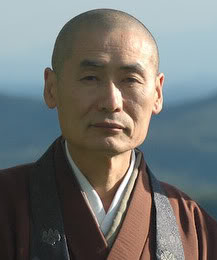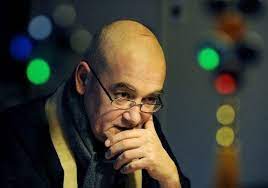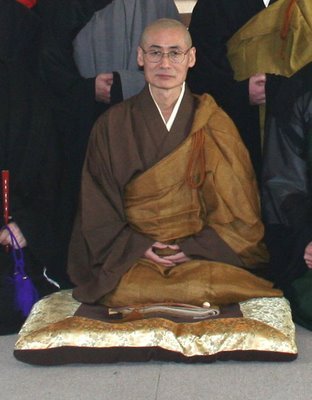ZEN MESTEREK ZEN MASTERS
« Zen főoldal
« vissza a Terebess Online nyitólapjára

采川道昭 Saikawa Dōshō (1949-)
国際布教総監 Kokusai fukyō sōkan (曹洞宗 Sōtō-shū, 南米 South America)
Biography of Master Saikawa Roshi
"Master Dôshô Saikawa is the abbot of Hossen Ji temple in the Yamagata prefecture in north west Japan. For many years he was responsible for welcoming foreign visitors to Sôji Ji temple in Yokohama, one of the two major sôtô zen temples in Japan.
He spent ten years travelling in the United States, serving various temples and helping to cultivate Sôtô Zen in the Americas. His understanding of occidental culture, along with his great personal attributes and teaching skills have been deeply appreciated by American and European Buddhists alike.
When I met Master Saikawa for the first time in June 1999 in Sôji Ji temple, our communication was instantaneous and I asked him if I could be his disciple. 'Why me?' he asked, 'in Japan there are much more prestigious teachers than I; they would be more interesting for you!' 'Because it's you!' I spontaneously replied while looking him straight in the eyes. At that moment the two of us burst into laughter...
Once he accepted, I travelled many times to his temple in Japan and to Sôji Ji to practice with him. He in turn has visited almost every year of the past ten to direct sesshins at Ryumon Ji. His contact with our sangha has been warm and remains strong. His intuitive intelligence and graceful spirit, his deep care for zazen, his human interaction full of humour and subtlety, his profound understanding of occidental culture, and the necessary adaptation of the japanese tradition in Europe, are the qualities that have created a veritable family relationship.
For the past three years, Master Saikawa has been responsible for Sôtô Zen in the entire continent of South America and therefore lives in Sao Paulo, Brasil.
My successive masters, Master Deshimaru and Maser Saikawa, are the founders of the temple Kosan Ryumon Ji in Weiterswiller.
My appreciation to them is immense and my gratitude without limit.

Olivier Reigen (霊元) Wang-Genh (1955-)
Abbot of Ryumon Ji
https://fr.wikipedia.org/wiki/Olivier_Wang-Genh
https://www.la-croix.com/Religion/Actualite/Olivier-Wang-Genh-le-zen-a-l-occidentale-_NG_-2009-04-27-534078

Regarding the 60th Anniversary
of Ryodaihonzan Betsuin
Busshinji and the Soto Zen
Buddhism South America Office
Rev. Dosho Saikawa
Director of the Soto Zen Buddhism
South America OfficeDharma Eye, No. 45, March 2020, pp. 1-3.
If I am going to speak about Soto Zen teaching
activities in South America, I must first
speak of the immigrant pioneers and the teaching
activities that took place in Peru. However,
due to limitations of space in this article, please
allow me to choose just a few things to write
about concerning the teaching activities of the
initial period.
Soto Zen teaching activities in South America
began in 1903 (Meiji era 36) when the second
boat carrying immigrants from Japan landed in
Callao Harbor and Rev. Taian Ueno embarked
from that boat. Rev. Ueno has been sent to Peru
as the person appointed by the Head Priest of the
Sotoshu, and build Jionji Temple in the town of
Cañete. This is where Soto Zen teaching activities
in South America began. Afterwards, a succession
of resident priests looked after Jionji and protected
and maintained Soto Zen teachings there.
Here in Brazil, Soto Zen priests also entered
the country following the arrival of immigrants
from Japan. The details for the beginning of Soto
Zen teaching activities in Brazil are almost the
same as they were in Peru. The first boat carrying
Japanese immigrants, the Kasado-maru,
arrived in Santos Harbor in 1908 (Meiji era 41).
Around this time, slavery had just been abolished.
Consequently, the Brazilian government
had adopted a policy of accepting immigrants
from many countries for the purpose of supplementing
the work force. Since it was not an environment
in which immigrants from Europe were
thought to be suitable for doing slave-like work,
a policy was adopted of accepting immigrants
from Asia and this is how the door was opened
for Japanese immigrants.
Afterwards, there was a debate in the
national assembly about whether to accept Japanese
people as immigrants. Since those in favor
and those against this measure were equal in
number, it was the chairman of the assembly
who, by casting his vote in favor, decided to
accept immigrants from Japan into Brazil.
Following this, World War II broke out. Since
Japan was a hostile country to Brazil, there was
a time when people were forbidden to speak
Japanese, and Japanese religions were also
prohibited. During the War and following it as
well, severe measures were taken such that in
order to be able to go to school, all children had
to receive Christian baptism.
After World War II was over, the ban on all
religions was lifted and Soto Zen activities were
given formal permission to begin.
It was in 1955, the year that the Head Priest of
the Sotoshu, Takashina Rosen Zenji, visited Brazil
for a preaching tour that he founded Zengenji in
Mogi das Cruces. Afterward, he officiated at the
ground breaking ceremony for Busshinji in Sao
Paolo. He then returned to Japan. Ten years later,
Takashina Zenji returned once again to Brazil.
Together with Rev. Ryohan Shingu, who had
been appointed in 1956 as the first Director in
South America, he traveled to various places
around the country for a preaching tour.In 1986, Rev. Shunkyo Aoki was appointed
as the second director. In 1992, Rev. Daigyo
Moriyama was appointed as the third director.
In 1995, at the time Rev. Moriyama was
Director, the 40th Anniversary took place. At
that time, a ceremony marking the completion of
the Main hall at Busshinji was held. The main
hall was built of ironwood which had been
imported from Paraguay. Very hard and dense,
this wood sinks when put in water. It is said to
be impervious to termaite, and is also less likely
to catch fire.
I was appointed as director in 2005, following
the fourth Director, Rev. Koichi Miyoshi. This
was exactly fifty years after Busshinji was given
its name and made Ryodaihonzan Betsuin by
Takashina Zenji in 1955. Since I arrived too late
to help with the preparations for the 50th Anniversary
and other events, it was decided to
calculate the 50th Anniversary from the time
Busshinji had been moved to its present location
in 1960, the time when it was designated a
religious corporation. For this reason, 2009 was
the year we marked the 50th Anniversary of the
founding of the Soto Zen Buddhism South
America Office and the founding of Busshinji. In
2019, the 60th Anniversary ceremonies were
held and faithfully carried out.
For the 50th Anniversary project, we built a
new building, the Daikankaku, the width of
which was the very limit of building regulations
at that time. The Daikankaku includes: a basement
level for parking and a small room for
ceremony; the first floor with a big hall
(Shiundo); and the second floor is a zazendo as
well as the founder’s hall (Kaisando). The
founder’s hall also serves as a room to house
memorial plaques and the ashes of our parishioners’
ancestors (Nokotsudo). The third floor is
the rooftop portion. Half of this area was divided
into two guest rooms, one of which doubles as a
dokusan room. The outdoor section of this floor
serves as the cemetery for the graves of the
temple’s founder and the successive resident
priests. There is also a space for successive
abbot’s stupa and five circles stupa for the
deceased who no longer have any family to look
after their graves (Muen kuyoto) and a permanent
memorial service (Eitai kuyoto) which has
been newly erected outside building.
For the 60th anniversary project last year, we
covered the roof and built two more rooms on
the third floor, one of which is a small hall for
multi-purpose use (Taihodo). The other room
now serves as the room for the Buddha-altar in
the memorial room for members’ ancestors
(Rosendo). Consequently, the ashes room that
was formerly on the second floor has been
moved out of the founder’s hall. Moreover,
thanks to the assistance from the Two Head
Temples (Eiheiji and Sojiji), we were able to purchase
land adjacent to Busshinji, a space of
approximately 3,600 square feet, which is now
called “Jinko-en.” We have made this area into a
park as a way of expressing our gratitude to
grass, trees, and all living things. In this park,
we have set up a Jinko Jizo Bosatsu stature, a
stupa dedicated to the myriad spirits of the triple
world (Sangai Banrei-to), and a sculpture by the
environmental artist, Toyota Yutaka, called “Star
of the Universe” that measures 3.3 meters by 6
meters. Finally, the small ceremony room that
had been in the parking area on the basement
level and which had been built for the 50th
Anniversary was converted to a memorial hall
for deceased pets and is now named “Hokoshitsu.”
This facility development at Busshinji has
been carried out as we look to the future. Our
intention is that these places can serve as the
center of teaching activities as they evolve in
South America. These places can serve as a
future overseas special training monastery without
any financial problems.
I will omit the contents of the 60th Anniversary
Memorial Service except to say that thanks
to the participation and support from many
people, everything was carried out successfully.
We were honored to have as guests the Assistant
Director Roshi and several other officer priests
from Daihonzan Eiheiji, the Director Roshi and
several other officer priests from Daihonzan
Sojiji, the Director of the Education and Dissemination
Division, and the Maneger of the International
Department of Sotoshu Shumucho, connections
to Busshinji’s founder from Kasuisai
Monastery including the Director of Ceremonies
as well as other officer priests, Takashina Docho
Roshi from Ankokuji Temple, the abbot of
Yakuoji Temple in Hokkaido, Sambe Specially
Dispatched Teacher, many other roshis and
senior priests, as well as trainee monks from
Eiheiji and Sojiji. From the beginning, this 60th
Anniversary was one that couldn’t have happened
without the love for the Dharma, support,
and cooperation from so many priests from
throughout Japan. I would also especially like to
express from the bottom of my heart my gratitude
to all Soto Zen priests and temples throughout
Japan.
![]()
Saikawa Roshi
Dôshô Saikawa Sôkan Roshi
https://monjaisshin.wordpress.com/about/dosho-saikawa-sokan-roshi/
Superior Geral da Escola Soto Zen para a América do Sul desde maio de 2005, Saikawa Roshi nasceu em Nagasaki, Japão no ano de 1949. Foi monge Theravada na Tailândia, voltou ao Japão e entrou na tradição Soto Zen ao receber ordenação do Shunmyo Sato Roshi em 1978. Treinou no Daihonzan Sojiji (1978-79) e Sojiji Soin (1979-81).
Depois de receber a Transmissão do Darma, foi Kaikyoshi no Zen Center of Los Angeles (1981-83), assistindo o Maezumi Roshi, e colaborando na formação do Zen Mountain Monastery (Daido Loori Roshi, abade) no estado de Nova Iorque.
Retornando ao Japão, tornou-se um dos oficiais professores no Templo Sede da Escola Soto Zen – Soji-ji, em Yokohama.
Tem alunos e grupos de Zazen nos Estados Unidos, Europa, Austrália, Japão, Brasil, etc. É professor de transmmissão de darma dos monges brasileiros Kôun (São Paulo) e Genshô (Florianópolis) e professor de numerosos outros monges-em-treinamento brasileiros. Foi professor da Monja Isshin de 2008 até 2010.
Dôshô Saikawa Sôkan Roshi é abade do Templo Hosen-ji em Yamagata-ken, Japão.
Em 2005, foi nomeado Kokusaifukyoshi (Professor Internacional) e assumiu o cargo de 総監 Sôkan (Superintendente) da Escola Soto Shu para a América do Sul e é o atual abade do Templo Busshinji em São Paulo.
“Muitos dos problemas podem ser resolvidos dentro da sua atividade mental. Mas esta questão acerca da verdadeira identidade, do verdadeiro si mesmo, da nossa verdadeira natureza, da questão da vida e da morte, não pode ser dissolvida dentro da atividade mental, não pode ser resolvida na psicologia, não pode ser resolvida na ciência, nem na filosofia porque todas essas respostas, nesses métodos, vem do dualismo. Esta questão de vida e morte está além dessa atividade mental.” ~ Saikawa Roshi